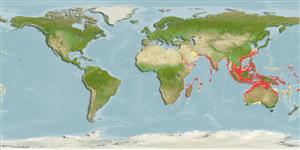Preferred temperature (Fonte Biblio.
123201): 23.6 - 28.5, mean 27.3 °C (based on 442 cells).
Phylogenetic diversity index (Fonte Biblio.
82804): PD
50 = 0.5000 [Uniqueness, from 0.5 = low to 2.0 = high].
Bayesian length-weight: a=0.00724 (0.00608 - 0.00863), b=2.92 (2.88 - 2.96), in cm total length, based on LWR estimates for this species (Ref.
93245).
Trophic level (Fonte Biblio.
69278): 4.5 ±0.6 se; based on diet studies.
Generation time: 11.0 ( na - na) years. Estimated as median ln(3)/K based on 1
growth studies.
Resilienza (Fonte Biblio.
120179): Basso, tempo minimo di raddoppiamento della popolazione 4.5 - 14 anni (K=0.10).
Fishing Vulnerability (Ref.
59153): Very high vulnerability (75 of 100).
🛈
Climate Vulnerability (Ref.
125649): High to very high vulnerability (73 of 100).
🛈
Nutrients (Ref.
124155): Calcium = 9.99 [4.90, 24.38] mg/100g; Iron = 0.237 [0.110, 0.480] mg/100g; Protein = 20.4 [18.5, 22.0] %; Omega3 = 0.0926 [, ] g/100g; Selenium = 48.2 [21.0, 111.8] μg/100g; VitaminA = 34.4 [8.7, 183.3] μg/100g; Zinc = 0.458 [0.304, 0.776] mg/100g (wet weight); based on
nutrient studies. 